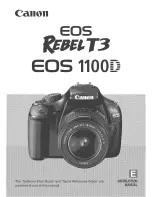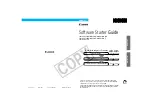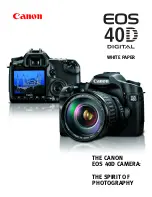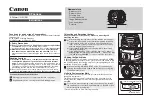
HP 912 Digital Camera User’s Guide
127
Glossary
exposure bar graph
The exposure bar graph displays the number of stops that the camera is under- or over-exposing in
+/- 3 stops. This bar graph is only displayed in the status LCD when the camera is set to the Program,
Shutter Priority (Tv), Aperture Priority (Av), or Manual exposure mode.
exposure compensation indicator
An indicator in the status and viewfinder LCDs that shows how much exposure compensation is being
applied, if any.
exposure lock button (AE-L)
See “AE-L button” on page 125.
exposure mode dial
A dial on the top of the camera that you turn to set the exposure mode.
exposure modes
The ten modes that you can select from to set the camera exposure to properly capture images, including:
Auto, Portrait, Landscape, Close-up, Action, Night, Program, Shutter Priority (Tv), Aperture Priority (Av),
and Manual. You turn the exposure mode dial to set the exposure mode. See also “Action exposure mode”
on page 125, “Aperture Priority (Av) exposure mode” on page 125, “Auto exposure mode” on page 125,
“Landscape exposure mode” on page 129, “Close-up exposure mode” on page 126, “Manual exposure
mode” on page 129, “Night exposure mode” on page 130, “Portrait exposure mode” on page 131, “Program
exposure mode” on page 132, and “Shutter Priority (Tv) exposure mode” on page 132.
file name
A set of letters, numbers, and symbols assigned to a file to distinguish it from other files on the computer
or in the camera.
file size
The number of bytes in a file. The file size for images saved on a digital camera is determined by the
resolution of the camera's CCD and the amount of image data compression. You can usually select the
amount of compression on the camera and again in the computer software that processes the images.
Note that if you compress an image on the camera and in the software, the compression is cumulative.
file type
The digital format in which a file is saved. Computer programs can insert or import files that were saved in
a file type that the program supports. Common file types for images include JPEG (Joint Photo Expert
Group format) and TIFF (Tagged Image File Format). See also “JPEG” on page 129 and “TIFF” on page 134.
firmware
The low-level software that runs in a digital camera and controls the functionality and user interface on
the camera.
firmware update
The process of updating to a new firmware version on the digital camera.
flash
A brief, intense burst of light from an electronic flash unit on a camera. Use flash when the lighting in a
scene is inadequate for taking pictures.
flash mode
This mode is set by pressing a status LCD button on top of the camera and determines how the flash will
operate.
flash mode button
A status LCD button on the top of the camera that you press to set the flash mode.
flash mode icon(s)
An icon or set of icons in the status LCD that shows the current flash mode.















































